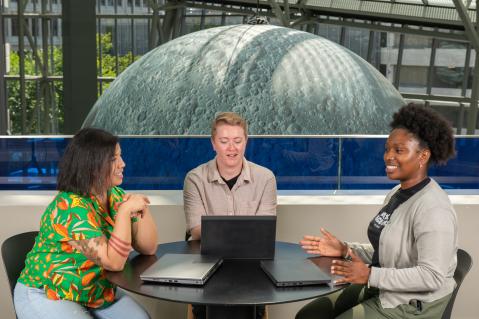
The Scholars program focuses on empowering students within 14 key research areas. Applicants are encouraged to align their research within these topics. There are points of contact listed for each topic, reach out with questions or email [email protected].
1. Artificial Intelligence and Machine Learning
Draper uses Artificial Intelligence and Machine Learning to provide critical capabilities to our advanced systems in the space, security, and military domains. However, an overarching challenge of using AI/ML in these domains is sparse, irregular, non-representative, or incomplete training data sets. Another challenge is building calibrated trust between the systems and users to prevent critical errors and increase adoptability into operations. Draper seeks methods to advance the state of the art in this field.
We would be targeting PhD students for the development of novel approaches and MS students for the application of existing approaches to specific problems of interest to Draper.
Technical Point of Contact
Margaret Duff
617.620.3907
[email protected]
Research Interests
Training successful AI/ML algorithms, especially deep learning models, requires large, comprehensive data sets that are similar to those collected in operation use conditions. In many of our domains of interest it is not feasible to generate large sets of training data because there are historically few examples or the events of interest are infrequent or unique. Additionally, many missions are extremely fast paced with high levels of uncertainty. Any AI/ML models must be trusted to operate in way that increases accuracy or efficiency without introducing unnecessary burden to the user or causing critical failures. Example applications that are of interest to Draper include:
a) Advanced Autonomy – enabling autonomous systems or agents to perform accurately and robustly in novel, complex, or uncertain situations.
- Collaborative control, tasking, navigation, or decision making
- Scene understanding and analysis, including multi-sensor integration, object persistence, contextual reasoning, and threat characterizatio
- Mission planning, mission management, and decision support
- ML models that can self-assess performance in areas such as uncertainty, data quality, or reliability
- Hybrid models that can integrate ML with expert systems
b) Digital Signal AI – using digital signal analysis to attack, protect, or support sensor, computing, or communication systems.
- Cognitive electronic warfare
- Cybersecurity
- Finding signal in noisy data
c) Biosecurity – identifying and responding to threats and events that have biological causes or biological consequences.
- Chemical, biological, radiation, and nuclear event prediction, detection, and mitigation
- Pandemic detection and response
- Multi-omic analyses for drug discovery or personalized treatment
d) AI-enabled Design and Manufacturing– improving manual, resource-intense optimization and manufacturing processes to create electrical, mechanical, or integrated hardware designs.
- Photonics gratings for miniaturized LIDAR
- Semiconductors or microelectronics
- Electromechanical systems
- Validation and verification
2. Advanced Position, Navigation and Timing
Draper has been active in the research and fielding of advanced positioning, navigation, and timing (APNT) for multiple decades. We have worked on, developed, and demonstrated APNT solutions that span celestial navigation to chip-scale atomic clock timing to underwater navigation modes. Draper’s APNT portfolio stretches across many domains and accesses all technology readiness levels. We continue to seek cutting-edge ideas and technologies that drive the state of the art forward.
We would be targeting PhD students for the development of novel approaches; and MS students for the application of existing approaches to specific problems of interest to Draper.
Technical Point of Contact
Dr. William Rice
617.258.2955
[email protected]
Research Interests
The ability to measure celestial objects across different spectral regions, using advanced imaging processing techniques, utilizing ultrasensitive detection techniques, and/or leveraging adaptive optics can enable significant increases in observational capacity and ultimately better positional accuracies. We seek to foster a number of different modalities that can improve the imaging of celestial objects (including those in Earth orbit). Some questions that we are interested in are:
- How can non-centrosymmetric optics be used to improve compact telescope designs (particularly by removing obscurants)?
- Can size-, weight-, and power-constrained focal plane arrays be built that examine multiple spectral regions? Can multiple focal plane arrays be used in highly limited form factors to increase spectral ranges?
- Are there novel methods for sensing and correcting incoming light through highly degrading environments or rapidly changing conditions?
- How can field of view be maximized while limiting or eliminating aberrations (spherical, chromatic, etc.)? Are there techniques, methods, or processes for achieving very high fields of view?
MEMS sensors have achieved success in commercial and other high volume applications. We are seeking to use MEMS technologies to precision applications. We are interested in advancements in the following areas:
- Development of high performance (~0.01 deg/hr) MEMS gyro.
- Development of micro-scale hemispheric resonator gyros using novel fabrication techniques.
- Development of discrete-mass, in-plane oscillator gyroscopes.
- New MEMS gravimeter designs that outperform existing mechanical gravimeters.
- Packaging and mounting technologies for MEMS sensors where mounting stresses in MEMS technologies are minimized.
A key challenge for APNT is distinguishing critical data from meaningless data. Traditional sensors accept all data that surpasses their detectability limits, which means that they are always on (power hungry) and are constantly outputting data (which necessitates processing capabilities).
The use of new methods, such as AI/ML, neuromorphic sensors, sparse sampling, and multi-hub/multi-node webs can help mitigate this data avalanche at the edge of the sensor/phenomena interface. We seek insights into the following questions:
- How can we use edge sensing/data fusion methods to reduce sensor power consumption and sensor failure rates?
- Can we use neuromorphic sensing methods to significantly evolve/change sensor functionality and operation without human intervention?
- For a given detection system, can we significantly improve processing capacity but still maintain overall detection capability by reducing irrelevant sensor outputs?
Atomic and molecular systems provide a set of highly precise and accessible energy levels that can be used for precision timing. Some questions we are seeking insight into are:
- How can we reduce the size of chip-scale atomic clocks? Can we move to much higher frequencies (e.g., terahertz) for intra-atomic coupling?
- How can we rapidly and accurately synchronize multiple independent clocks that are spatially separated?
- Beyond the commonly used systems, what other atomic or molecular gases have the potential to achieve very high timing precision? Can the ancillary support structures also be miniaturized and packaged?
We seek advancements in atomic and molecular sensing of electric and magnetic field, such as:
- Use of Rydberg atoms to simultaneously sense both electric (RF) and magnetic fields. Can detectability be increased? Can the detection be shown to be vectorized?
- Atomic gravimetry for precision sensing of gravity in highly constrained (size, weight, and power) packages and/or unstable platforms (e.g., moving vehicles, airplanes, ships, etc.).
- Use of atomic or molecular gases for very high precision magnetic field detection (magnitude or vectorized).
- Low-dimensional materials for sensing acoustics (air or underwater) at very specific frequencies (narrowband) and very high detectabilities.
- Ionic, atomic, dopant, or vacancies in materials that can be used for magnetic field sensing, such as nitrogen vacancies in diamond, dopants or inclusions in optical fiber for Faraday rotation detection, or magnetic dopants in quantum dots.
A new generation of materials has shown that when the material size becomes similar to or less than the size of relevant quantum wavefunctions, new capabilities and novel physics can be achieved. We seek a greater understanding of how room-temperature phenomena in these materials can be used in chip-scale packaging for very sensitive detection or manipulation of electric, magnetic, acoustic, optical, or quantum behaviors. Topics may include:
- Spontaneous self-assembly of materials to form a simple device or sensor.
- High-performance materials (e.g., graphene, topological insulators, phase-change materials, etc.) that can be used for sensors that manipulate light.
- Electrical control of light-matter interactions, such as rapid control over indices of refraction, high-speed manipulation of reflection/absorption/transmission, or coherent energy transfer to/from incoming light in a narrowband frequency region.
- Materials that can be used for novel acoustic sensors.
The use of precision-controlled light using unique geometries and tailored refractive indices enables a radical reduction in the size, weight, and power across the APNT spectrum. We seek to explore topics in photonics such as:
- Squeezed light for improvements in accelerometry, imaging, or sensing.
- Ultrasensitive and size-reduced sensing of rotations and linear movements in photonics.
- The use of topological photonics for novel APNT solutions.
- Flat optics for precision imaging and/or optical control.
- Photonics for observing through degraded optical environments or unique spectral regions.
- Photonics for detecting, sensing, or measuring vibrations and acoustic perturbations.
3. Autonomy
Draper has been active in the research, development, and fielding of autonomous solutions for multiple decades. From multi-week duration underwater vehicle missions to spacecraft mission planning, real-time planning for autonomous parafoils, or multi-agent ground and air vehicle cooperation, we apply autonomy across many domains and at all technology readiness levels. We continue to seek cutting edge ideas and technologies to push the stat of the art forward.
We would be targeting PhD students for the development of novel approaches; and MS students for the application of existing approaches to specific problems of interest to Draper.
Technical Points of Contact
Mitch Hebert
617-352-5847
Brett Streetman
617-352-0446
Research Interests
As autonomous vehicles proliferate, mission designs naturally move towards multiple autonomous agents working in cooperation to solve problems. We seek frameworks applied to multiple agents that don’t just enhance single vehicle capabilities but instead enable new mission designs and revolutionary advances in autonomous team achievements.
In large and complex engagements, many open questions remain when incorporating autonomous agents with operators, decision makers, and planners. Some questions we are seeking insight into are:
- What level of centralization vs. decentralization in command and control is optimal in an engagement? How does this change as the environment, enemy, and resources evolve?
- What level of autonomy should be given to agents in a large operation? How does this change as the environment, enemy, and resources evolve?
- What is the optimal teaming formulation (crewed, uncrewed, crewed-uncrewed) to complete an objective? How does this change as the environment, enemy, and resources evolve? How is the trade-off between successfully completing this mission vs. reserving resources for future engagements made?
There has been a push by governments and the space-industry to increase the amount of verifiable autonomy used in orbit operations and extra-terrestrial exploration. We seek advancements in spacecraft autonomy that can apply to Earth orbit, the moon, and beyond.
Robust navigation is an underpinning to higher level autonomy functions. We seek vehicle navigation and perception technologies that operate robustly both with and without GPS across domains from underwater to beyond Earth orbit.
We seek planning and decision making frameworks that have an awareness of system uncertainty and can present operators with optimal plans including knowledge of uncertainty before and after planned actions.
Although Draper has been successful in fielding autonomous systems across domains, we are constantly seeking for ways to decrease the development and fielding times while increasing our robustification, continuous testing, and V&V capabilities. To meet the increasing performance guarantees required by these advanced autonomous systems and our customers, we are seeking research PhD and MS level research in simulation, V&V, automated field testing, and enabling advanced autonomy architectures.
Even though there have been signific advances in AI based autonomy over the past decade, there are still areas that warrant additional research to increase the field-worthiness of these proposed approaches. Specifically, we seek AI research in the sub-fields of mission planning, explain-ability and robustness measures, AI-based planning and battlefield estimation heuristics, GN&C, and swarm tactics.
4. Biotechnology
Draper has established a major presence in the biotechnology domain, working with a range of key government and commercial stakeholders on critical applications ranging from biosurveillance and clinical diagnostics to therapeutic screening for drug development and for screening of medical countermeasures for high priority pathogens.
We are interested in exploring Draper Scholar opportunities for both MS and PhD students pursuing graduate research programs in the Life Sciences / Microbiology, Bioengineering, and other related disciplines and academic departments.
Technical Point of Contact
Dr. Jeffrey T. Borenstein
617.258.1686
[email protected]
Research Interests
Infectious diseases are one of the largest threats to global public health. Factors such as climate change, increased population growth, expansion into animal habitats, and prevalence of antimicrobial resistance have led to emergence of novel pathogens as well as rise of previously controlled infections. The ability to rapidly monitor the spread of disease is crucial for prevention, interference and control. With the emergence of SARS-CoV-2, wastewater surveillance has shown to be a useful rapid approach for monitoring disease spread and levels in the community. Additional pathogens have been shown to be detectable in wastewater, allowing for the monitoring of multiple circulating pathogens. The principles of wastewater biosurveillance can extend beyond the general public to the government agencies to help monitor safety and threats against key assets and locations in addition to other complex environmental samples. Development of rapid pathogen agnostic detection is necessary to protect communities against and prevent spread of novel infectious threats.
Draper has been developing organ-on-chip technologies toward a range of applications for over two decades, with a central focus on engineered tissues for disease modeling, safety testing and drug development, and for screening of medical countermeasures against high priority pathogens. While engineering platforms for these model systems are fairly well-established, several key technical advances could augment and expand capabilities toward key drug development and biosecurity applications. These include:
1) The development of new organ models beyond Draper’s current portfolio, with particular interest in neural and cardiac models.
2) The integration of immune components into organ models.
3) The development of new disease models such as for thrombosis and coagulopathy applications.
4) Automation of downstream assays via innovations in microfluidics and related domains are also key to driving down the costs and increasing the throughput of these model systems. Advancements in organ-on-chip technologies will enable rapid response to emerging threats and improve medical countermeasure development.
Modeling emerging threats and developing mitigation strategies requires an ever-advancing set of capabilities for analyzing data obtained from clinical samples, preclinical animal studies, and model systems such as organs on chips. Conventional analytical tools provide a limited window into the dynamics of pathogenesis, including entry, replication, and immune downregulation, which has resulted in a dearth of countermeasures despite years of research. Novel capabilities in single-cell analysis and in capturing and probing multi-omics datasets including proteomics/genomics, epigenomics and the microbiome, will be critical in designing increasingly complex and powerful model systems for the investigation of disease mechanisms and evaluation of therapeutic approaches. Integration of these multi-omic readouts at both the tissue and single-cell levels will ultimately contribute to accelerated response to emerging threats, and reduced costs and wider availability of vaccines and therapeutics during health emergencies.
5. Cyber
Cyber-physical systems security is one of Draper’s core capabilities. Draper’s intimate knowledge of hardware and software vulnerabilities is used to both: (i) inform secure design decisions to protect the entire compute stack; and (ii) develop offensive capabilities. Draper’s approach is comprehensive and relies on research from formal methods, system security, advanced packaging, secure processors, and offensive cyber security.
Draper cyber-physical system security spans four broad, complimentary domains that use deep understanding of the hardware-software interface to develop solutions for some of our nation’s premier, strategically important systems.
We would be targeting PhD students for the development of novel approaches; and MS students for the application of existing approaches to specific problems of interest to Draper.
Technical Point of Contact
Silviu Chiricescu
617.831 3883
[email protected]
Research Interests
This research area covers security mechanisms, along with the associated compositional aspects, to protect the entire compute stack. We are dealing with strong, nation state adversaries, and our solutions must withstand the most sophisticated attacks. Thus, Draper is interested in collaborations that span a wide range of topics including:
- Secure processor design that includes methods to (formally) verify the (generated) hardware and its security properties (i.e., lack of side channel leakage, integrity and confidentiality of the computation, and reverse engineering and Fault Injection protections).
- Secure software stack design that includes secure firmware, operating systems and languages, property-based fuzzing, compiler transformations to enforce security policies, etc.
Draper applies a wide range of formal methods to understand and then modify programs (in source code or binary form). Our analyses include static, dynamic, and hybrid approaches. We are interested not only in scaling and extending existing approaches, but also creating languages and tool interfaces to make these analyses useful for others. Research topics of interest include:
- Specification composition/synthesis, proof automation (i.e., in Coq, Agda, etc.), counterexample guided inductive synthesis.
- Secure compilation, sound decomplilation, weakest precondition analysis, abduction inference, abstract interpretation.
- Mathematical topics (e.g., type theory, homotopy, category theory, program logics), hyperproperties, datalog/e-graphs.
This research domain covers a broad area of offensive techniques at both the hardware and software layers. Specific areas of collaboration include:
- Reverse engineering and vulnerability research approaches and tool development, focused on cyber-physical systems.
- Novel hypervisor development for code protection, instrumentation, and code obfuscation techniques.
- Research into defeating hardware-based software protections within IoT/Embedded systems.
- Compiler-based techniques including automatic generation of exploits based on X-oriented programming, transformations to increase diversity and obfuscation (i.e., static and dynamic opaque predicates, etc.), taint analysis, control follow analysis, etc.
- Operating systems exploitation including via process injection, packer techniques, networking stack, etc.
- Analog-based attacks (i.e., RF, acoustic, power, etc.) and physical attacks
- AI-driven exploit campaigns, AI poisoning, etc.
This recently established research domain takes a multidisciplinary approach to solving tough problems in cyber by harnessing the power of machine learning and artificial intelligence. Research topics plan to include:
- Building machine learning models that have the power to identify adversarial techniques tactics and procedures (TTPs) in network traffic, executables, and source code.
- Delivering cyber security to the edge via AI; this includes techniques for hardening IoT devices, military hardware and software, and space systems that automatically adapt to protect the high value assets.
- Leveraging LLMs to aid in the analysis of firmware, binaries, and malware, helping to alleviate some of the manual labor for reverse engineers.
6. Design Methodology
Draper has a very strong history of advanced electro-mechanical design of extremely high performance systems. We continue to explore state-of-the-art methods to advanced design in harsh environments.
We would be targeting PhD students for the development of novel approaches; and MS students for the application of existing approaches to specific problems of interest to Draper.
Technical Point of Contact
Will McFarland
617.992.8525
[email protected]
Research Interests
Advanced methods of electromechanical design that challenge the current way of ‘doing design’ are sought. We’d like to apply innovative design methods that have potential to achieve extreme performance, ultra-low SWAP, and / or ruggedized operation in harsh environments (e.g. Long-duration Space, Hypersonics)
Example areas might include:
a) Minute deformation in extreme thermal environments
b) Novel, low-SWAP electro-mechanical sensors
c) MEMS Stirling engine
Draper may share specifics of particular interests once the collaborative research topic are has been agree to.
Visual Communication of a complex, multi-dimensional, inter-related design space has proven very effective in improving design decisions and accelerating the design process. Novel methods and approaches for visualization of the design space, as well as tools and methods for exploring the tradespace within designs are sought. Again, Draper may share specifics of particular interests once the collaborative research topic are has been agree to.
Draper frequently works on complex engineering design problems that require tradeoffs and optimization across many criteria and constraints. Generative design algorithms can help engineers navigate these large trade spaces by automatically creating and optimizing diverse designs that can outperform manually designed systems across many variables (e.g. size, weight, power, materials, lifetime, etc.). We are seeking novel approaches to AI-driven generative design to increase performance, improve efficiency, or reduce time to manufacture in relevant engineering domains such as electro-mechanical systems, micro-electronics, and bio-engineering.
7. Humans Systems Technology
Draper has a very strong history of human systems technology efforts focused on characterization and quantification of human signals to infer state and intent. We are seeking additional approaches and methodologies for collection and development of quantitative multimodal metrics.
We would be targeting PhD students for the development of novel approaches; and MS students for the application of existing approaches to specific problems of interest to Draper.
Technical Point of Contact
Andrea Webb
617.258.4131
[email protected]
Research Interests
Complex human state attributes (e.g., stress, fatigue) can be difficult to quantify robustly and reliably and can vary widely both within and across individuals and contexts. We are looking for novel analytic approaches that make use of a variety of multimodal data to generate meaningful and reliable metrics of human state attributes.
Data from wearable and non-contact sensors can be sparse and/or messy and of poor quality. We are looking for novel approaches to combat these challenges and maximize the information that can be obtained from these signals. Signal process and machine learning approaches are both of interest.
Commercially available devices (e.g., Fitbit, Apple watch) are commonly used to collect data and make inferences about health and state. We are looking for approaches that leverage these types of werable devices to collect more nuanced metrics (e.g., beyond gross heart rate) and other types of analogous internet of things devices to understand human state and intent. In particular, we are interested in ideas and approaches for ‘in-the-wild’ (i.e., not in a controlled lab setting) data collection approaches and metrics to understand and appropriately make use of the context in which the data are collected.
8. Hypersonics
Over the past 15+ years, Draper’s efforts have supported the nation’s reinvigorated interested in hypersonic technologies and systems. Initially our efforts focused on Navigation, Guidance and Control technology but have since broadened to benefit from the full breadth of the Laboratory’s expertise, to include: hypersonic vehicle technology, hypersonic propulsion technology and Command and Control capabilities to manage the employment of hypersonic capabilities.
Technical Point of Contact
Mike Lotito
617.639.3767
[email protected]
Research Interests
Draper’s Hypersonic Vehicle Technology interests are pictorially shown in Figure 1 below.
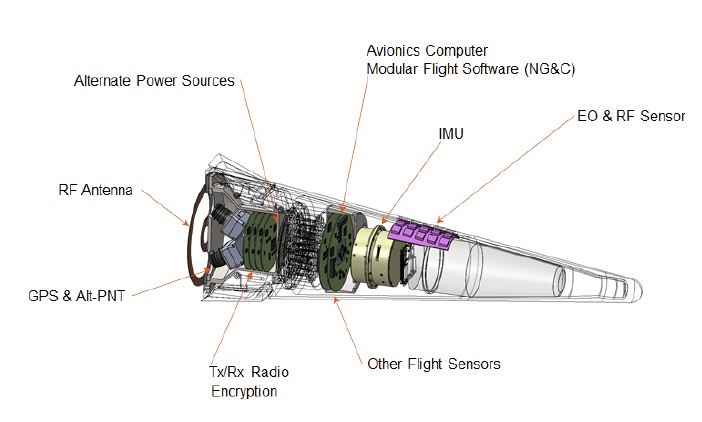
a) EO & RF Sensor: Sensors that can be used to localize potential targets. Sensor includes targeting algorithms
b) Tx/RX Radio: Transmit and receive radio that can receive and send friendly messages or waveforms and/or be used for electronic warfare purposes
c) RF Antennas: RF antennas to enable receipt or transmission of RF signals. Omnidirectional, beam nulling and/or beam steering with applicable clutter and noise rejection technologies
d) Alternate Power Sources: Safe, high power density sources
e) Miniature actuators that can be employed to affect aerodynamic control either locally or globally
Draper’s Hypersonic Propulsion Technology interests are pictorially shown in Figure 2 below.
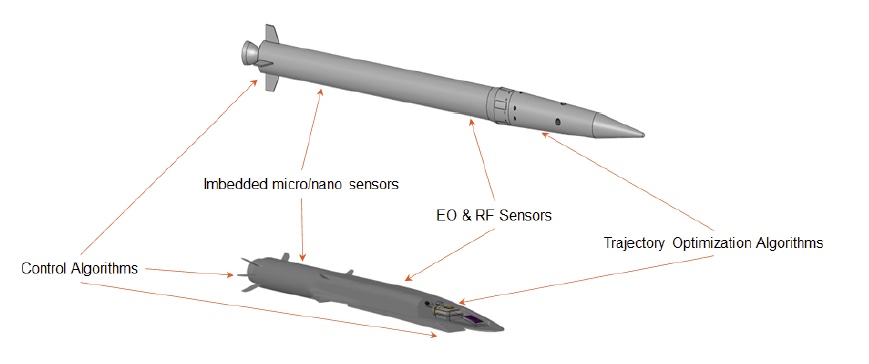
a) Control Algorithms: Guidance and control algorithms that enable hypersonic
propulsion flight while minimizing resulting stresses on the airframe and/or
minimizing propulsion energy losses
b) Imbedded micro/nano sensors: sensors imbedded in the structure and/or
propellant to enable better understanding of the systems aging and potential
resulting degradation
c) Miniature actuators that can be employed to affect aerodynamic control either locally or globally
Draper’s Hypersonic Command and Control Technology interests are pictorially shown in Figure 3 below.
a) Detection and Tracking Algorithms: Algorithms that enable detection and tracking of high speed flight vehicles using current and future sensors and sensor modalities, data processing techniques (including AI/ML)
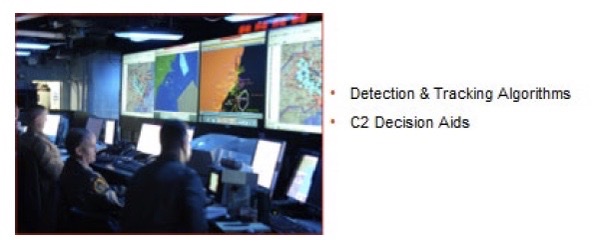
b) C2 Decision Aids: Decision aid technologies that enable processing of detection, tracking and targeting signals, target typing and data assimilation such that human leadership can quickly absorb incoming information and quickly make actionable plans and courses of action. This includes hardware and software, display approaches, display set ups, data aggregation techniques, automated information processing, etc.
9. Materials Design & Development
Draper has a strong history of advanced materials design and development for extremely high performance systems.
We would be targeting PhD students for the development of novel approaches; and MS students for the application of existing approaches to specific problems of interest to Draper.
Technical Point of Contact
Dr. Kasia Oleske
617.258.2704
[email protected]
Research Interests
Space probes and other high reliability systems have a need for power in remote, harsh environments that require novel materials development to meet growing power and thermal management requirements while still maintaining small form factors. Today there are no micro power systems that have efficiencies greater than ~2% which meet all mechanical, thermal, and system requirements for small form factor power needs. Other areas of interest include novel materials and architectures that have potential to enable new energy and power systems that achieve extreme performance, ultra-low SWAP, and/or ruggedized operation in harsh environments. Example areas might include:
a) Microelectronic coolers
b) High temperature thermoelectric materials
c) Radiation and neutron based power systems
d) Battery development
e) Piezoenergy transfer systems
f) Supercapacitors
Draper may share specifics of particular interests once the collaborative research topic has been agreed to.
Rapidly printing 3D structures enables new applications across a wide variety of fields biological systems, communication systems, and various electronic systems. These fields require techniques that enable at least one or more of the example areas below
a) Print smaller structures
b) Print performance materials
c) Conformal
d) High temperature tolerance
e) Flexible
Draper may share specifics of particular interests once the collaborative research topic has been agree to.
The efficient transfer of data through high temperature, high radiation, remote, and/or other harsh environments is critical to ensure sufficient guidance navigation and control and information gathering.
Example areas might include:
a) High temperature, rad hard transducers
b) High temperature, rad hard electronic materials
c) High temperature, rad hard insulation materials
d) Undersea communication systems
e) Hypersonic window materials
f) Enabling antennae materials and structures
g) High temperature materials and coatings
h) Dust- and debris-tolerant electronic and PMAD system components
i) Novel sealing/bonding technologies for extreme environments
Draper may share specifics of particular interests once the collaborative research topic has been agree to.
1. Polymeric Materials Development - Developing more accurate polymer based models will allow for rapid design across various systems and environments (ex. high temperature), high fidelity failure prediction and prevention which would advance US manufacturing by decreasing development costs and increasing reliability across many business sectors including electronics, biotechnology, & aerospace applications. Current approaches use microscopic models that are difficult to integrate at the system level. We’d like to develop a lumped element, plug and play non-linear model of polymer materials for Comsol type environments so that if material parameters are known and if interface features are inputs then the polymer behavior over time, temperature and stress is predictable. The focus areas might include smaller electronics systems but over a wide range of temperatures and stress, general polymer-ceramic arrays, bonded interfaces, and potted component models.
2. Alloy Design and Development – Developing novel alloys enables unique material properties coupled with stability under harsh mission conditions. Leveraging computational techniques allows for rapid screening of new and existing compositions and deeper understanding of potential processing conditions and capabilities.
3. Molecular Dynamics – Understanding how the surface chemistry of a material interacts in a harsh environment or how the structure of the material impacts the mechanical properties is critical to many mission applications. Being able to quickly screen or evaluate novel materials can enable rapid materials development that would otherwise be impossible to gain any significant insight into without extensive and challenging testing. Pre-screening candidates can help focus experimental work on the most promising candidates.
10. Photonics Packaging
Draper has a core interest in precision navigation and timing, and many of these systems use optical components. Recent advances have enabled photonic integrated circuits (PICs) that have a large number of optical components on a single chip. The packaging of such PICs presents a considerable challenge because it is difficult to couple light on or off a PIC. Various methods are being explored for convenient optical packaging.
Technical Point of Contact
Steven Spector
617.429.0330
Research Interests
Figure 1 shows a Draper PIC with a fiber attached. This fiber was attached using manual alignment.
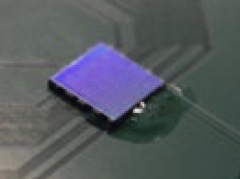
Better methods would allow:
- Automated attachment
- A large number of optical connections
- A very large number of electrical connections (ex. bump bonding).
- Compatibility with different waveguide material systems (Silicon, III-V, LiNbO3, garnet)
- Vertical optical coupling to free space (for LiDAR or
- Free Space Optical Communication applications)
- The ability to couple to different mode shapes and sizes
- The ability to add and remove disposable PICs in the field
It is unlikely that a single method can simultaneously serve all these needs, but all these needs do impact systems in which Draper has interest. It is therefore preferred to meet all these needs with as few unique methods as possible. Many institutions are actively researching improved optical coupling methods to meet these needs [1].
Methods can be divided into two categories, depending on whether they couple light from the edge of chip or from above. The most common method for coupling light from above is by using a grating. This method lends itself to standard planer fabrication methods but is limited in efficiency and bandwidth. A technique with better performance in these areas is shown in figure 2 [2]. This method uses a 3D mirror to both direct and focus the light to above. The fabrication of such a mirror is a challenge and Draper is exploring an alternative method to fabricate integrated mirrors. This method uses self-assembly of gold nanoparticles, functionalized with DNA, to create pyramids aligned to wells in the substrate, as shown in figure 3 [3] [4].
This is one method of light coupling that is of interest, but other methods, such as adiabatic tapers, photonic wirebonding and are also of interest. Also of interest are the aspects of packaging other than light coupling, such as the physical packaging itself and improved methods for alignment.
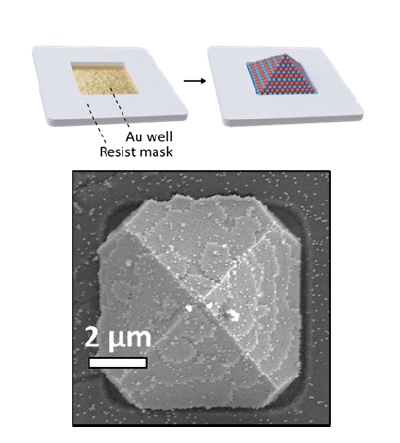
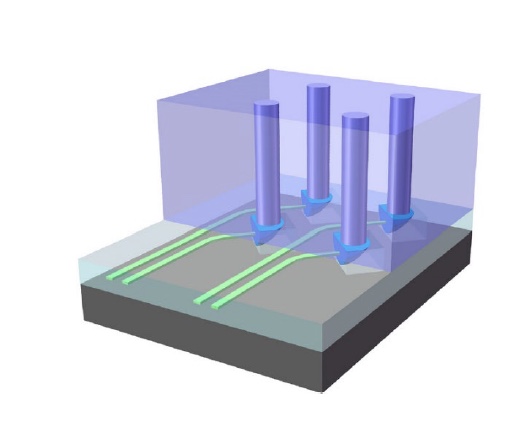
11. Rad-Hard MicroElectronics
The development and characterization of radiation-hardened and high reliability electronics is a key enabler for Draper’s efforts to support the nation’s strategic and space systems. Our research interests include development of novel technologies, novel approaches to radiation-sensitive system elements, and characterization of state-of-the-art technologies for high reliability radiation environments.
We would be targeting PhD students for the development of novel technologies and studying complex phenomena. We would be targeting MS students for the characterization of existing technology and application to specific problems of interest to Draper.
Technical Point of Contact
Dr. Brian Munroe
617.258.3693
[email protected]
Research Interests
While improvements to processes and materials offer the possibility of incremental improvement in the radiation hardness of semiconductor devices, demonstration of vacuum microelectronic systems would represent a step-change in hardness. Draper would like to pursue demonstration of this technology and associated processes, such as:
a. Proof-of-concept of a vacuum-insulated transistor-like devices at useful voltages
b. Development of wafer-level packaging techniques compatible with high- or ultra-high-vacuum inside the package
Many commercial technologies and processes either have not been evaluated for the Draper mission space or have been shown not to meet the needs of some Draper applications. Characterization of these existing devices or development of novel processes to address these challenges would be extremely interesting. Some example research areas are:
c. Evaluation of long-life, high-reliability uses of commercial devices, such as long-term drift in consumer inertial sensors or stress relaxation in wafer-scale bonds
d. Heterogenous integration of different processes or technologies, with a focus on leveraging different rad-hard technologies into a single device with multiple capabilities
e. Development and characterization of wafer-scale bonding techniques that are compatible with the long-term operation of stress-sensitive MEMS components
f. New concepts for MEMS sensor auto-calibration
g. Study of anelastic and inelastic behavior in MEMs materials, including dielectric and metal layers
New processes and technology nodes, such as the 12LP process from GlobalFoundries or gate all around (GAA) field effect transistors, show promise for producing radiation-hardened devices. Systems that require rad-hard technologies typically also require high reliability performance. These new processes need to be characterized for both reliability and radiation hardness in a variety of environments. Similarly, existing high-reliability processes (e.g., automotive devices) should be evaluated for radiation hardness in the natural space environment (NSE).
Example areas might include:
a. Experimental characterization of devices made on various SOTA technology nodes
b. Evaluation of neutron single event effects (nSEE) for different nodes and processes across multiple neutron source spectra
c. NSE evaluation of high-reliability components and sensors. For example, automotive parts for use in space.
Certain components required in a system are more sensitive to radiation than others. These devices are critical to the operation of the system and often require significant compromises in system design to accommodate them. Development of novel approaches that are transformative changes in the state-of-the-art would enable a variety of new applications and approaches to Draper’s key challenges. Critical devices that are of interest include power conversion technology, non-volatile memory, and precision voltage and timing references.
12. Sensors and Comms
Draper prides itself on high performance, low SWAP sensing technologies across a wide range of sensing modalities able to operate in operational environments. To support these sensors, we are also interested in low-power communications technologies and other supportive methods and technologies
We would be targeting PhD students for the development of novel approaches; and MS students for the application of existing approaches to specific problems of interest to Draper.
Technical Point of Contact
Dr. Bradley Kaanta
857.259.9367
Research Interests
Draper seeks advanced concepts, designs and demonstrations of novel, low SWAP sensing across a wide range of sensing modalities - emphasizing, but not limited to inertial, clocks, optical, CBRN, EO/IR, quantum (sensing only) and magnetic. Sensor packaging for harsh environments and sensor integration for broader system use are also of interest.
Draper seeks advanced concepts, designs and demonstrations of novel, low SWAP communications technology and networks. Of particular interest is temporary and dynamic systems in operational environments. Low frequency electromagnetic systems (sensors, transmitters, and signal processing) are also of merit.
Novel methods for sensor fusion that increase the information content using multiple sensors with different sensing modalities continues to be a challenge of interest. Demonstrations of advanced estimation and fusion algorithms with simulated and / or actual data are of most benefit. AI/ML methods should be able to work with sparse data, or have application areas that are known to have abundant data.
13. Space Technology
Draper has an extensive and proud heritage in space beginning with the selection by NASA as the first prime contractor on the Apollo program. Throughout the ensuing 60+ years, Draper has continued to make significant contributions in civil and commercial space, including NASA’s Artemis and Commercial Crew Programs, NASA science missions, and commercial robotic/autonomous exploration missions.
We would be targeting PhD students for the development of novel approaches; and MS students for the application of existing approaches to specific problems of interest to Draper.
Technical Point of Contact
Dr. Kevin R. Duda
617.258.4385
[email protected]
Research Interests
Draper is investing in advancing our mission-planning technology – which has heritage in low-earth orbit (LEO) technology demonstrations, terrestrial undersea applications, and terrestrial unmanned aerial vehicles. We are interested in innovations that advance the state-of-the-art in mission-enabling autonomy to support human and robotic space missions beyond LEO, such as cislunar operations (including the lunar surface), include AI/ML technologies when appropriate, and are certifiable to relevant NASA software standards. Draper may share specifics of particular interests once the collaborative research topic has been agreed upon.
The ability to navigate a spacecraft is critical to all space missions. Draper is interested in architectures and technologies (both hardware and software) to support autonomous precision navigation in cis-lunar space (including on the lunar surface). Approaches that enable new missions, or fill gaps in current mission concepts, minimize size, weight, and power (SWaP), and can operate autonomously for extended durations in deep space are of particular interest. Again, Draper may share specifics of particular interests once the collaborative research topic has been agreed upon.
The ability to be situationally aware in space (SSA) requires unique space-based sensors with innovative sensing modalities, mixed sensor suites, and algorithms for detection, identification, and tracking of objects in both near and far proximity to a space asset (e.g. cubesat). Draper is interested in novel sensors, algorithms, and system approaches to SSA for LEO through to cislunar domains. Draper may share specifics of particular interests (e.g. field of view; field of regard; accuracy; etc.) once the collaborative research topic has been agreed upon.
Fault tolerant computer architectures satisfy NASA safety requirements by providing the reliability and redundancy necessary for human-rated NASA systems, enabled by highly reliable computing elements, are also required for commercial and science missions that must have mission availability. Draper is investing in technologies such as our software based redundancy management (which was developed for NASA’ Space Launch System) and highly reliable electronics to satisfy the growing need for edge-computing and/ high reliability / fault tolerance in space. We are interested in advances in technologies, algorithms, and approaches to fault-tolerant computing and architectures to support these needs, including radiation hardening and high-temperature electronics. As with the prior research areas, Draper may share specifics of particular interests once the collaborative research topic has been agreed upon.
14. Terrain Relative and Vision-Aided Navigation
Draper’s vision-aided navigation (VAN) and terrain relative navigation (TRN) areas have been developed for terrestrial (air and ground), undersea, space-based orbital and landing applications, and wearable technology. The technology is most useful in GPS-denied and lighting-constrained areas. Advancing this technology includes utilizing new sensors in GPS-denied environments, increasing the robustness and accuracy of the measurements, advancing the simulation systems to test the measurements, and easily integrating the measurements with existing navigation systems.
We would target Masters and PhD students. As an example, Masters students can perform design sensitivity studies, and PhD students can develop novel algorithm approaches.
Technical Point of Contact
Ann Dietrich
857.331.3670
[email protected]
Research Interests
a. Sensitivity to different lighting conditions for vision-based navigation, and develop methods to improve VAN robustness to changes in lighting conditions and seasonal terrain
b. Increased autonomy for TRN onboard vehicles including optimized database search methods, optimized feature detection, and reduced processing power
a. Explore other measurements that do not rely on optical and visual sensors, such as IR and LIDAR measurements.
b. Focus on developing these measurements in shadowed or low-light scenarios, such as at night terrestrially, undersea, in high-contrasting shadows such as at the moon, and at small bodies.
a. Expand our TRN technology to navigate on the surface of Earth or another planetary body such as the Moon and Mars. Focus on wearable tech for humans and rovers.
